In this post, I’ll share my best practices for sales introduction emails and then walk you through tried-and-true templates with 60% or higher open rates, 8% or higher click-through rates, and 30% or higher response rates. I've lightly edited the templates so you can tweak them for your industry, market, product, and prospect.
Table of Contents
- Sales Introduction Email Best Practices
- Best Sales Email Templates
- Use Email Templates to Nurture More Leads
Sales Introduction Email Best Practices
- Make your subject line captivating.
- Keep it simple.
- Introduce yourself.
- Include a clear call-to-action.
- Included a personalized email signature.
- Make sure you follow up.
How many sales introduction emails are you planning to send today? Consider your prospects. They are likely receiving several sales emails daily — many of which are spam, full of false promises, or aren’t personalized to the recipient’s needs.
Here are some ways I get my emails noticed.
1. Make your subject line captivating.
The subject line is the most critical part of an email, with 47% of recipients opening emails based on the subject line, and 69% using the same factor to report emails as spam.
If prospects aren’t motivated to explore beyond your subject line, the time and effort you put into the content, messaging, and CTA of your message is for naught.
One trick to boost email opens is to include your recipient’s name in the subject line. Undoubtedly, this gets tricky when you send sales emails at scale. Sales software simplifies this process considerably compared to a salesperson’s personal email client. It helps sellers to automate email sequences and personalize messages using your contact list and other CRM data.
2. Keep it simple.
The longer the email, the more likely the target recipient will skim or simply ignore the content after a cursory glance.
- Keep your emails simple, starting with the subject line (around five words).
- Don’t overload your prospects with information.
- Provide them with an idea and guide them to follow up for more information.
According to HubSpot research, the ideal sales email length is between 50 and 125 words. Brevity and clarity FTW!
Pro tip: During my sales career, I would either end my emails with a line from a testimonial or an ROI statistic. I would invite the prospect to talk about whether they wanted to achieve similar results. I found it effective at motivating responses.
3. Introduce yourself.
You can’t assume that your prospect knows anything about you or your company. One of the first things you should do is introduce yourself.
- Include your name, your title, the name of your company, and your value proposition.
- If you are sending your prospect your first message, briefly describe the value your company offers to your target market. (This makes it easier to transition to asking whether the recipient has a need that aligns with what you do.)
Introducing yourself confidently and without gimmicks or false promises is a great way to set yourself apart from the other sales emails a prospect receives that day or week. People buy from people they know, like, or trust.
4. Include a clear call-to-action.
Don’t be vague. After receiving a sales email, your prospect should have a clear idea of what the next step is. Are you asking them to respond to an email? Should they reach out by phone? Do you need them to schedule a time on your calendar using your meeting scheduler?
Include a clear call-to-action in your email so your prospects aren’t left wondering what to do.
Pro tip: I always thought my most important job when I wrote sales emails was keeping the recipient engaged enough to read down to the call to action. I had a fishing analogy where the subject line is the bait and hook that I would cast into the “lake,” which represented my target market. The body of the email is how the seller reels in the prospect, and keeps them engaged enough to be drawn “into the boat” with the call to action.
5. Included a personalized email signature.
Set up a custom email signature to stand out and appear more trustworthy. It should include your name, job position, and/or logo of the company you work with.
Add extra contact details like your phone number and links to your website or social accounts. These allow prospects to learn more about you and reach out through other methods if they wish to do so.
6. Make sure you follow up.
Following up is crucial to forwarding the conversation, and you should aim to do it at least two or three times. Sometimes my best email results were from drip campaigns.
The first email would be a preview of a sequence of messages that would introduce a concept or campaign message. It told the prospect to anticipate the next email would follow with an offer that would be of great value to them, because I did my research, and was confident it would be of strategic value.
The second email would describe the offer or the promotion and include a content asset like an ebook or a webinar. It would give the prospect the option of acting right away, or tell them to keep an eye out for a third message.
I found that by getting the prospect used to seeing messages from me without a hard sell, they were more likely to open my messages and respond than if I tried to use one email and call to action to try and spark the relationship.
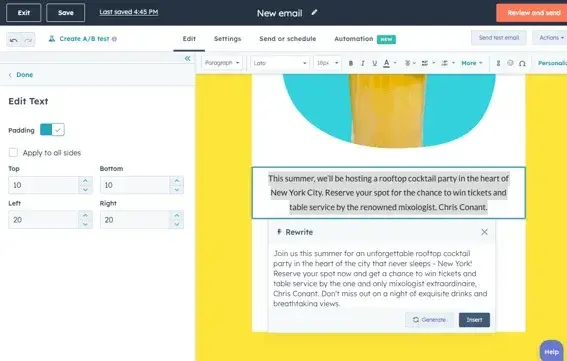
Pro tip: If you want a hand when you start writing your emails, try using HubSpot’s free AI email writer for a quick productivity boost — in place of staring for hours at a blank screen. You can also use it to easily customize emails using slash and highlight commands to edit length, spelling, and tone.
Sales Introduction Email Templates
Here are some email templates you can try, with some direct feedback and ideas from me.
1. Standard Sales Introduction Email Template
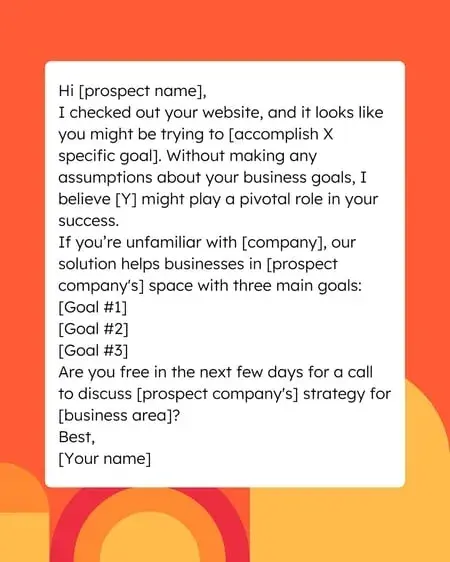
Subject line: Are you doubling down on [goal]?
Hi [prospect name],
I checked out your website, and it looks like you might be trying to [accomplish X specific goal]. Without making any assumptions about your business goals, I believe [Y] might play a pivotal role in your success.
If you’re unfamiliar with [company], our solution helps businesses in [prospect company's] space with three main goals:
- [Goal #1]
- [Goal #2]
- [Goal #3]
Are you free in the next few days for a call to discuss [prospect company's] strategy for [business area]?
Best,
[Your name]
If the prospect hasn‘t heard of you before, give them a reason to talk to you. Mentioning their goals and showing you did your homework is often enough to pique a buyer’s interest.
Why It Works: In a sales introduction email, you are introducing yourself to a stranger. For most, it is easy to brush off or ignore someone they don’t know. This email template puts you in a position where your prospect might not know you, but they think you know them. By focusing on their goals and success, you can draw them in. As you mention how your company can aid in their success, you can move your company out of the stranger category and potentially facilitate a conversation.
Mark’s Take: I would probably change the subject line to something like “Taking your [goal] strategy to the next level?” or “What’s your next move for achieving [goal]?” I wouldn’t want to suggest that pursuing a goal I want to talk to them about requires lots of effort or risky “doubling down.”
The body of the email is great, but I think prospects are already reluctant about the risk of working with a salesperson or company they don’t know. Using a gambling metaphor doesn’t seem like a good idea.
2. Trigger Event Email Template
Subject line: Congrats [Client Name]! Let’s discuss next steps
Hi [prospect name],
Your [LinkedIn description, company’s recognition in the Inc. 500, connection XYZ colleague] inspired me to reach out. My company has worked with several staffing firms to help them cope with the kind of growth trajectory your company is on. Within six months of working with [company], [client] saw [X results]. I’d be happy to share a few ideas about how [prospect company] could accomplish similar results.
If you’re open to it, when would be a convenient time to chat? Say, [XYZ time]?
[Your name]
Strike while the iron is hot. A trigger event gives you a compelling reason to reach out, boosts your credibility by demonstrating you clearly pay attention to what's happening in their space, and establishes urgency.
Why It Works: Corresponding with a stranger can seem so unexpected that you’re put off by the initial interaction. The trigger event email template allows prospects to bypass this discomfort because you’re reaching out for a reason. This trigger event makes your email seem more valid and less like spam.
Mark’s Take: Keep the focus on the prospect, don’t make it about your product. Offering to discuss next steps communicates confidence and approachability.
3. Offering a Better Solution Template
Hi [prospect name],
I'm [your name] with [company name]. I help sales executives to discover the benefits of collaborative sales tools that they can use to better communicate with their teams. Many of the customers we’ve onboarded recently had great visibility to management-level forecast data. Yet their direct reports struggled to keep their managers informed about their activities and challenges. Does that challenge seem familiar with the sales tools you use?
[Your product name] resolves this issue by [Share main benefits]. What day works best for setting up a demo?
[Your name]
Why It Works: If you know what tools your prospect is using, you can offer your product as a better solution to their pain points. This technique enables you to quickly point out the competition's flaws and how your product resolves those friction points — making it a better fit.
Mark’s Take: Talk about your strengths or your success stories. If you know where your product excels, focus on that. Don’t compare it to a gap in the competitor’s feature set — it’s important you find a way to earn the prospect’s trust, and trashing a competitor is a risky way to do so.
4. Complimentary Email Template
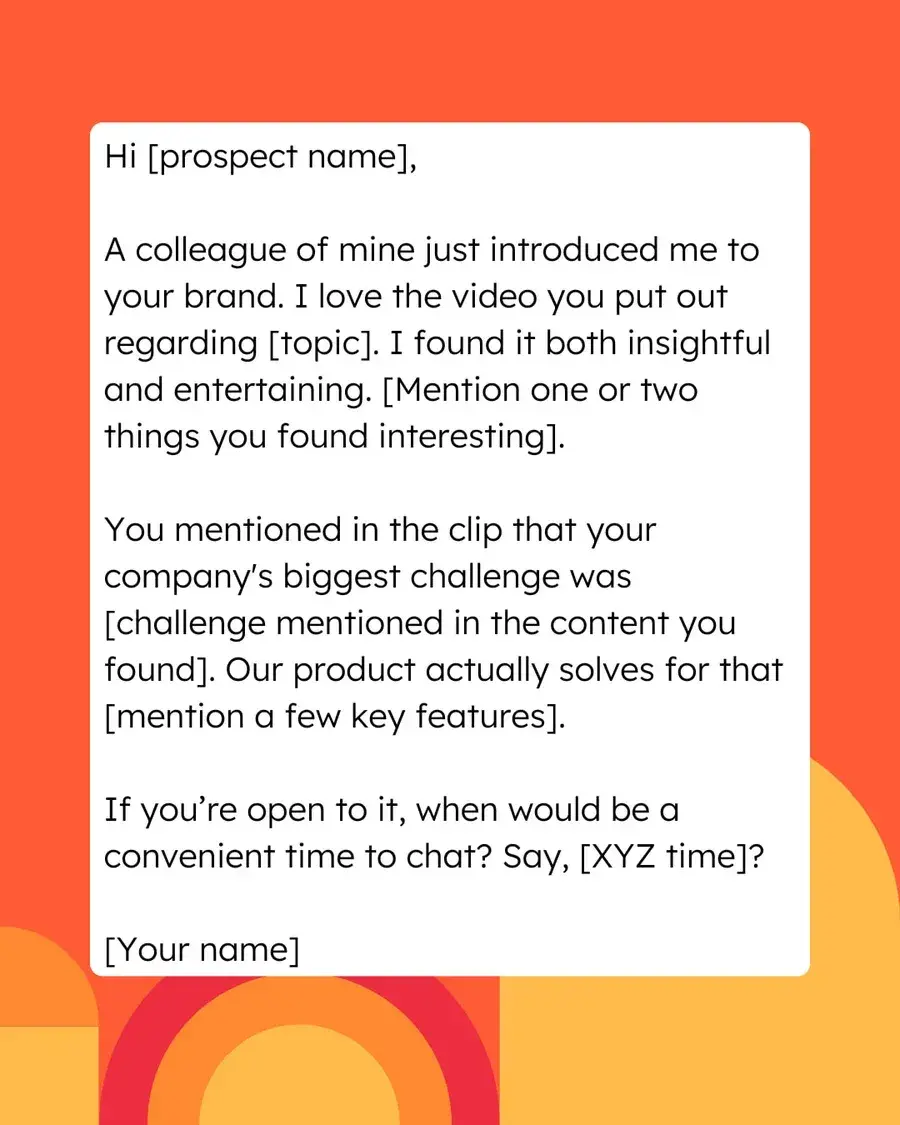
Hi [prospect name],
A colleague of mine just introduced me to your brand. I love the video you put out regarding [topic]. I found it both insightful and entertaining. [Mention one or two things you found interesting].
You mentioned in the clip that your company's biggest challenge was [challenge mentioned in the content you found]. Our product actually solves for that [mention a few key features].
If you’re open to it, when would be a convenient time to chat? Say, [XYZ time]?
[Your name]
Why it Works: This method works when the compliment is genuine and the rep has done proper research on the prospect. Flattery is a powerful tool that can help build rapport and connection with a prospect and make it more likely they'll respond to your email.
Mark’s Take: This template could be very effective, but it’s important not to gush, and possibly come across as insincere.
5. Mutual Contact Reference Email Template
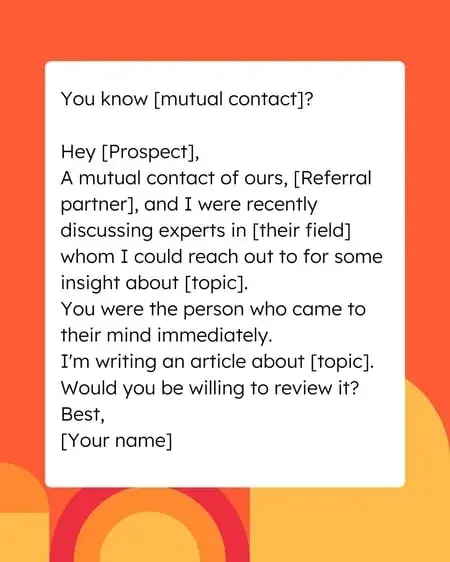
Subject line: You know [mutual contact]?
Hey [Prospect],
A mutual contact of ours, [Referral partner], and I were recently discussing experts in [their field] whom I could reach out to for some insight about [topic].
You were the person who came to their mind immediately.
I'm writing an article about [topic].
Would you be willing to review it?
Best,
[Your name]
In a lot of ways, sales is the art of cultivating trust with potential customers. One of the better ways to do so is by finding some common ground via mutual connections, peers, or former colleagues.
Taking this angle can add some degree of familiarity with your prospects, put them at ease, and give you a leg up in the trust-building process.
Why It Works: “It’s not what you know, it’s about who you know.” Connections play a substantial role in the business world, and this perception is what makes this email template successful. A mutual contact instantly establishes a level of trust and credibility with a potential client. If there is a perceived connection between you and your prospect, they will be more willing to transform that connection into a relationship.
Mark’s Take: I’ve used this approach successfully, and word-of-mouth referrals are great. But I’ve also seen salespeople who didn’t really have permission to name-drop a common connection. Awkwardness ensued.
6. Useful Resource Email Template
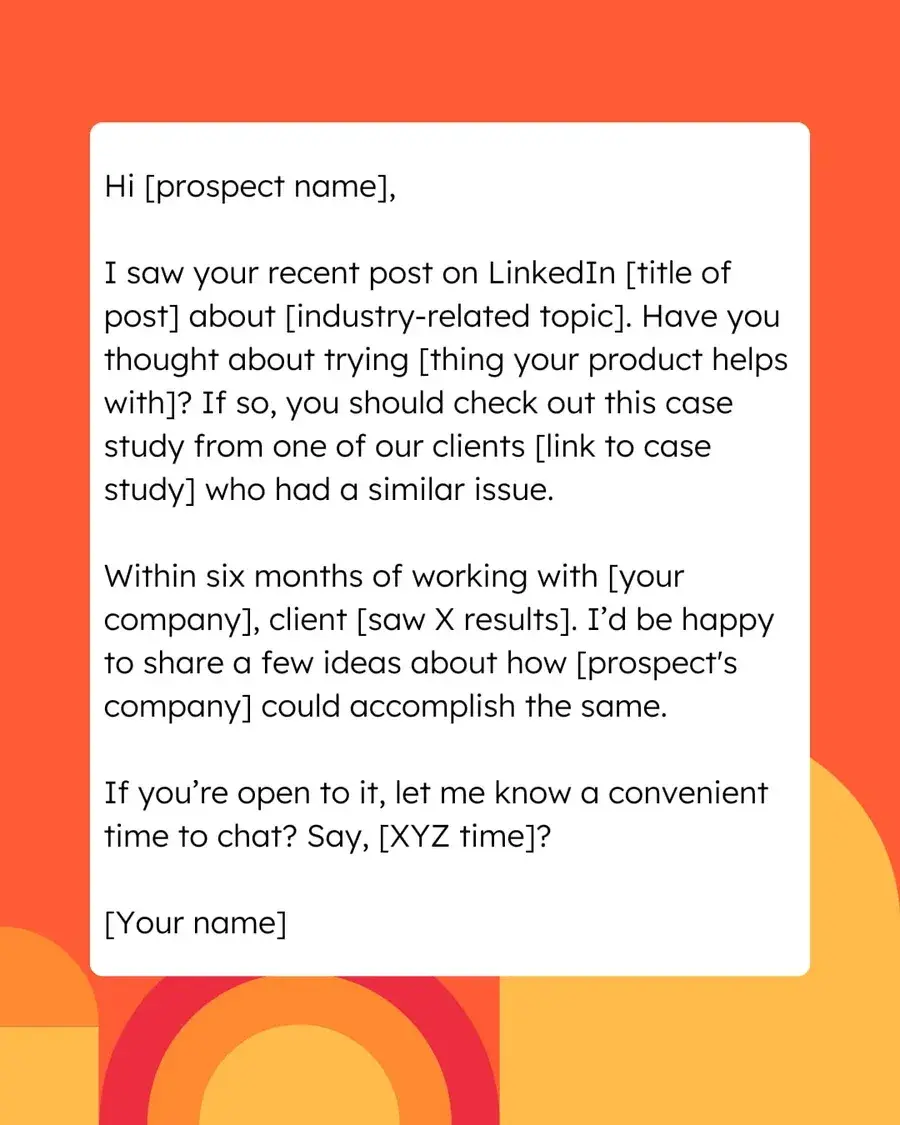
Hi [prospect name],
I saw your recent post on LinkedIn [title of post] about [industry-related topic]. Have you thought about trying [thing your product helps with]? If so, you should check out this case study from one of our clients [link to case study] that overcame a similar challenge.
Within six months of working with [your company], client [saw X results]. I’d be happy to share a few ideas about how [prospect's company] could accomplish the same.
If you’re open to it, let me know a convenient time to chat? Say, [XYZ time]?
[Your name]
Why It Works: One of the easiest ways to hook prospects is to provide them with value from the start. In the example above, the rep pulls out a challenge the prospect may have mentioned and then provides them with a case study showing how a company solved similar issues using their product, and that the process can be replicated at the prospect's company.
Mark’s Take: I remember that sales coaches would recommend I use the word “challenge” instead of “issue” because challenges can come across as forward-looking or aspirational, while an issue can be quite negative. To improve this email, I would try out an A/B test with prospects and swap out those words.
Best Sales Email Templates
7. Website Visitor Email Template
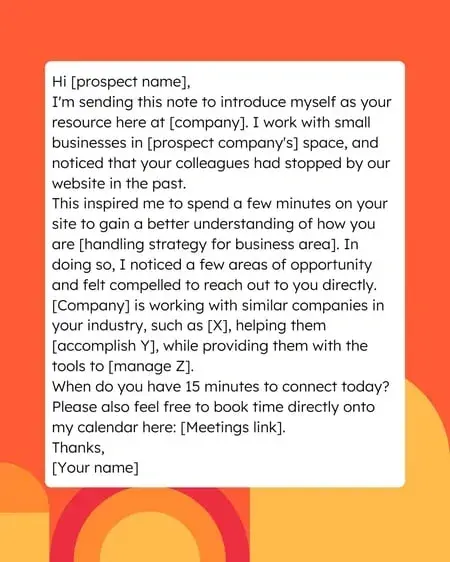
Subject line: Resource for [business area] questions
Hi [prospect name],
I am a business development specialist in [prospect company's] industry, and noticed that you and a few of your colleagues visited our website recently.
This inspired me to spend a few minutes on your website to gain a better understanding of how you are approaching [business strategy]. In doing so, I noticed some opportunities where my company could help you attain your goals, and I was compelled to reach out to you directly.
[YourCompany] is working with similar companies in your industry, such as [X], helping them [accomplish Y], while providing them with the tools to [manage Z].
Do you have 15 minutes available on your calendar to connect this week?
Please also feel free to book time directly onto my calendar here: [Meetings link].
Thanks,
[Your name]
Based on the prospect‘s browsing behavior, you know they’re at least interested in your solution. If you want to capitalize on that interest, position yourself as a trusted advisor who can guide them through the decision-making process.
Why It Works: Without an explicit answer, it is virtually impossible to know why a prospect clicked out of your website. The website visitor email template opens a door to discovering where the interest in your products or services ended. It allows you to draw interest back into your company while enticing prospects with the notion that their competitors are using similar methods. It provides them with a direct line of communication to explore new opportunities with your products or services.
Mark’s Take: I’d use a stronger subject line. Something like “Let’s achieve your [business goal] together.” Positioning yourself as a trusted advisor shouldn’t seem like an offer to be a sounding board before you buy elsewhere. The internet is for answering questions; don’t devalue your worth.
8. New Prospect Email Template
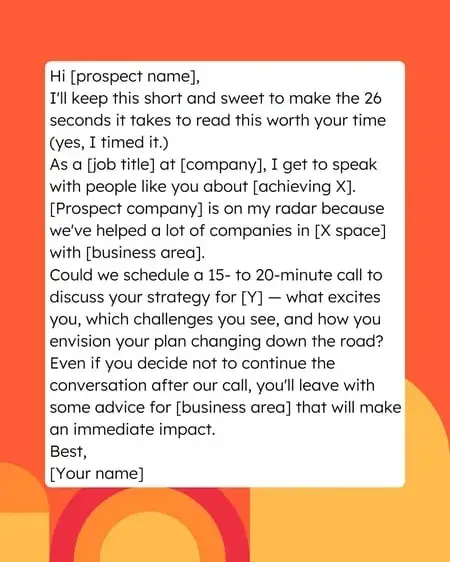
Subject line: [Prospect Name], are you pressed for time?
Hi [prospect name],
Your time is valuable, so I’ll get right to the point. As a [job title] at [company], I get to speak with people like you about [achieving X]. [Prospect company] is on my radar because we've helped a lot of companies in [X space] with [business area].
Could we schedule a 15- to 20-minute call to discuss your strategy for [Y] — what you are working towards, which obstacles you are faced with, and how you envision your business rising to the occasion? I am confident you will take away some valuable ideas for tackling [business goals] that could make an immediate impact to your [top/bottom] line.
Best,
[Your name]
The first touch email is the most important one you'll send. Like the first template in this list, this email will give your prospect an overview of your company while showing off your knowledge of their organization.
Why It Works: Cold emails are challenging because you’re looking to establish a relationship with someone potentially unaware of both you and your company.
Mark’s Take: This template works because it demonstrates a respect for prospects’ time, but makes it clear that if they invest time with you, they will get value for their time investment. It isn’t an aggressive sales pitch either, so the prospect won’t feel pressured into an unexpected sales call.
9. Recent Voicemail Email Template
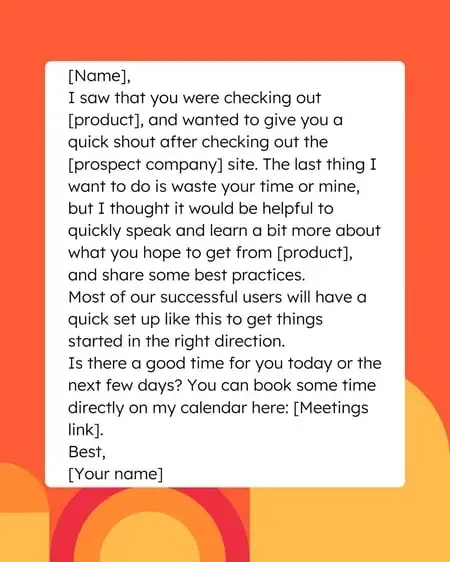
Subject line: [prospect name] — My recent voice message
[Name],
I saw that you were considering investing in our [product or service], and wanted to connect with you to ensure we address your needs..
Is there a good time for you in the coming days? You can book some time directly on my calendar here: [Meetings link].
Best,
[Your name]
P.S. Thought you might like this as well while getting started:
- [Helpful link #1]
- [Helpful link #2]
Why It Works: It is easy to skip over a voicemail, especially when it’s coming from an unknown caller. Prospects are likely to ignore unsolicited messages. This voicemail follow-up email template is one way to establish your credibility so they aren’t tempted to delete your voicemail before hearing your offer. Many prospects are reluctant to take calls from strangers in today’s business climate. This email strategy helps introduce you to the prospect before opting into a discovery call.
Mark’s Take: Voicemails are all too easily deleted or forgotten, so following up is critical to ensure you get a response.
10. Requested Demo Email Template
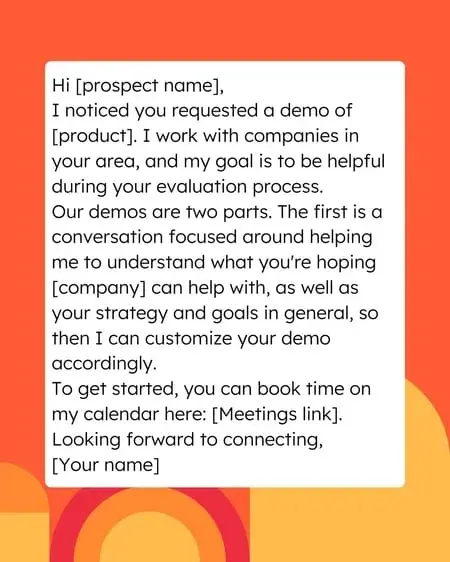
Subject line: [Prospect Name’s] request to explore our [product]
Hi [prospect name],
I understand that you requested a live demonstration of our [product]. I work with companies in your area, and my goal is to ensure you can make an educated decision as to whether our [solution] meets your business goals and requirements.
My company takes a two-step approach to providing personalized demonstrations to ensure we address your unique needs. The first step is to have a discovery conversation focused around the use cases you would like us to present to you, to get some context as to how your users would be applying our platform into their business day. I would then tailor the demonstration environment to the scenarios we discussed, and make sure we are focused on what features and benefits are most important to your business. I’ve found that it is much more effective to take this approach than assuming your needs and walking you through a generic demo which may not address what you are most interested in.
To get started, you can book time on my calendar here: [Meetings link].
Looking forward to connecting,
[Your name]
Why It Works: This email helps you establish a relationship with the prospect and set the right expectations for the process. If they're not prepared for a discussion of their company and objectives before the nuts-and-bolts product talk, they might become impatient.
Mark’s Take: We live in a world of instant gratification. When a prospect requests a demo, they create an idea of when they can expect to receive the information. It is often sooner rather than later. The requested demo email template is necessary for managing expectations. It establishes a timeline and helps form a relationship with your prospect instead of instantly opening and closing the door with the requested demo.
11. Free Tool or Trial Email Template
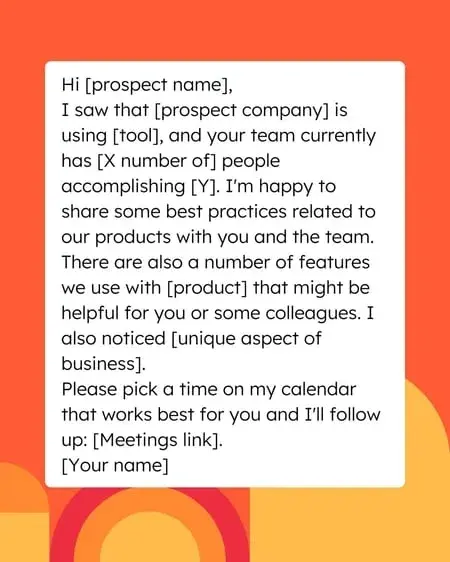
Subject line: X people on your team using [product]
Hi [prospect name],
I saw that [prospect company] is test-driving/using the no charge version of our [platform], and your team currently has [X number of] users accomplishing [Y]. This message is an invitation to discuss your experience so far, and to see if there are features or functions that might better align with how your business operates.
Your business needs might be addressed by our basic plan, yet there are several advantages to activating a paid subscription that can help you achieve quick wins, and long term return on your investment.
Trial Scenario 1: Our trial provides you complete access to all our features for [X more] days, so I wanted to make sure your team is familiar with how to access the features and benefits that matter to them most. I would be happy to arrange a conference call with your team.
Freemium Scenario 2: The Basic plan has a number of valuable features, and they are a great way to start transforming your business workflows. Many of our customers started on the basic subscription tier, but as they learned about the benefits of the paid-tier functionality, the ROI was easy to justify.
Please choose a time on my calendar that works best for you and I'll follow up: [Meetings link].
[Your name]
Why It Works: A free trial or freemium experience is pivotal. During this time, prospects expect to be wowed by your products or services — wowed enough to commit to paying for them. The free tool or trial email template works because it shows potential clients or customers that you’re on their side. You want them to get the biggest bang for their buck. You want them to succeed. When prospects think your company is willing and able to help them, they are more likely to engage.
Mark’s Take: Help your prospect get as much out of their free sign-up or trial as possible. Not only will this help them see the value of your product, it also lets you influence their purchasing criteria.
12. No Response to Original Email Template
Subject line: Are you still investigating [goal] strategies?
Following up on my last email, I wanted to see if [increasing X, decreasing Y] are on your priority list. I am eager to share some insights I’ve learned from working with organizations like yours.
[Company] offers tools for [business area] that include the following:
- [Feature #1 and why it's helpful]
- [Feature #2 and why it's helpful]
- [Feature #3 and why it's helpful]
Should we find some parallels between your needs and what my company could offer you, I'd be happy to present some approaches to addressing your business needs with our industry-specific solutions. My goal would be to help you make an informed decision as to whether my company’s offerings align with your objectives.
I look forward to your positive response. If you aren’t responsible for this initiative, and there is someone in your organization that would have a vested interest in this area, please feel free to forward this message on, or I would be happy to make direct contact.
[Your name]
Why It Works: Sometimes a prospect needs a push in the direction of your company. After the initial email, there’s a chance they forgot about your offer. They might not be sure how your company can help them. Remind them. Inform them. A nonresponse doesn’t always mean they’re not interested. The “no response when opened” email template can help your company return to the minds of those who are.
Mark’s Take: The prospect is interested in learning more — after all, they read your message — but they‘re either too busy to respond or not interested enough. Get the conversation going again with an explanation of your company’s solution and an offer to give them a demo.
13. Continued Nonresponse Email Template
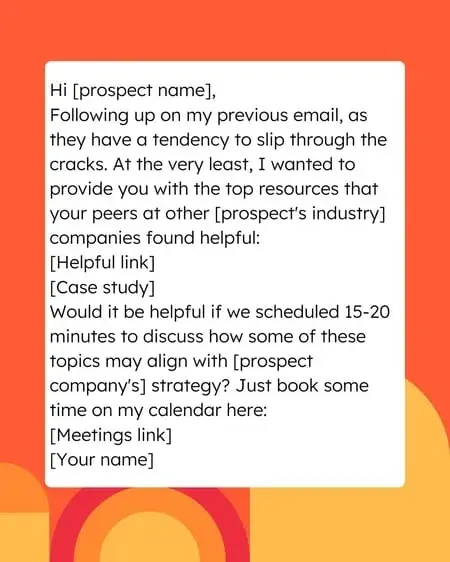
Subject line: Resources used by [competitor #1] and [competitor #2]
Hi [prospect name],
Following up on my previous email, as they have a tendency to slip through the cracks. At the very least, I wanted to provide you with the top resources that your peers at other [prospect's industry] companies found helpful:
- [Helpful link]
- [Case study]
Would it be helpful if we scheduled 15-20 minutes to discuss how some of these topics may align with [prospect company's] strategy? You can book time on my calendar via the link below. Otherwise, all the best to your business, and I hope to work with you in the near future.
[Meetings link]
[Your name]
Why It Works: Heard nothing? Before you give up on this prospect, send a few more resources their way. You'll add value while simultaneously reminding them your tool might be able to solve a pressing pain point — as it has for their competitors.
Mark’s Take: After a few tries, you have to consider that your prospect isn’t interested. The continued non-response email template works for two reasons. One, it puts your company back into the mind of your prospect. Two, it helps draw them in with resources they can use to propel their goals.
14. Re-Engaging a Non-Responder Email Template
Subject line: Not as bad as an awkward first date
Hi [prospect name],
Looks like we might not be meant for each other. But I still wanted to reach out to you one last time. I have a few suggestions on how [prospect company] can [accomplish X and Y]. If I don‘t hear back, I’ll assume that the timing isn't right.
In the meantime, here are two resources I thought you might find valuable because [reason why they're relevant]:
- [Link #1]
- [Link #2]
Best,
[Your name]
Why It Works: People think there is always time. The door is always open, so there is no haste in action or a decision. The “re-engaging of a non-responder” email works because it forces potential buyers to realize that they are about to miss an opportunity. When it looks like the door is finally closing, they could be motivated into action.
Mark’s Take: This lighthearted email gives the buyer a chance to change their mind. I think it’s a great way to re-engage them without guilt-tripping them.
15. Building Rapport Email Template
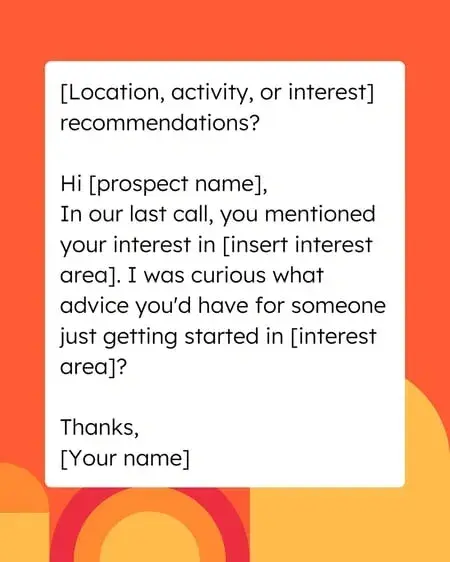
Subject line: [Location, activity, or interest] recommendations?
Hi [prospect name],
In our last call, you mentioned your interest in [insert interest area]. I was curious what advice you'd have for someone just getting started in [interest area]?
Thanks,
[Your name]
Why It Works: No one wants a ton of offers shoved in their face. If your prospect has lost a bit of interest, the building rapport email template helps slowly draw them back in. Instead of meeting them with an offer for your products or services, asking a question about their business or seeking advice can jump-start the conversation. It also shows your prospect that you’ve paid attention.
Mark’s Take: Let‘s say your conversation has stalled a bit and you want to keep the momentum going without being too pushy. Try a rapport-building approach. It requires you to know a little about the person you’re sending an email to — just another reason why it's important to get to know your prospect in your initial outreach and discovery calls.
16. Taking Action Email Template
Subject line: Where do we stand?
Hello [prospect name],
We've been unable to connect for a few weeks now, and that usually means one of two things:
- 1. This isn't a priority for you and your company at the moment.
- 2. You've been busy and we should keep trying to connect.
If the answer is option one, I won't take up any more of your time. Otherwise, do you have time to connect this week?
Thanks,
[Your name]
Why It Works: While connecting with a prospect isn’t a waste of time, it could be a waste if they’re dragging their feet and uninterested in your company. The taking action email template works because it compels them to make a decision. If they are disinterested, you can save your resources and end the correspondence or regroup for a different approach. If they are interested and still hope to connect, it confirms that you can go to greater lengths to secure this client.
Mark’s Take: Sometimes you've spent so much time on a deal that you simply need to know if the prospect is interested in moving forward. If they keep rescheduling meetings, missing calls, or pushing for a longer discovery period, it might be time to cut to the chase.
17. Responding To Content Email Template
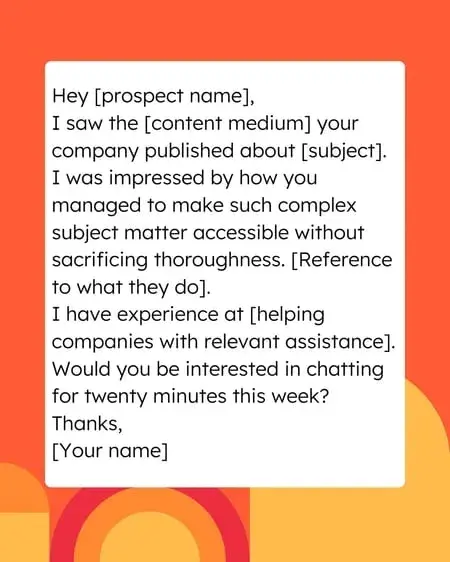
Subject line: Love your recent article!
Hi [prospect name],
I saw the [content medium] your company published about [subject].
I was impressed by how you managed to make such complex subject matter so accessible without sacrificing context or your authentic experiences. [Reference to what they do].
I have experience at [helping companies with relevant assistance]. Would you be interested in chatting for twenty minutes this week?
Thanks,
[Your name]
Why It Works: As shallow as it sounds, people are driven by compliments. Additionally, we always strive to do better. The “responding to content” email template appeals to both. This email will initially catch the eye of your prospect because of its reference to their content. After stroking their ego, you can drive a conversation with the idea of helping them do even better.
Mark’s Take: Prospects like to know you've taken a sincere interest in their business. One of the better ways to demonstrate that interest is to take the time to read, understand, and offer constructive guidance based on the content they publish.
18. Congratulating Prospects Email Template
Congratulations!
Hey [prospect name],
Congratulations on [recent achievement]!
Your company’s growth and success are really gaining traction in [their industry].
I'm looking forward to seeing where you go from here.
Regards,
[Your Name]
Why It Works: Sales emails typically request something from the prospect — a response or phone call. This email template works because it makes no request. Congratulating your potential clients on achievements puts you in favor with them and keeps a positive relationship open for future pitches.
Mark’s Take: Do your research and stay abreast of any milestones they reach. Then, reach out and reference those big-time wins.
19. Re-establishing A Connection Email Template
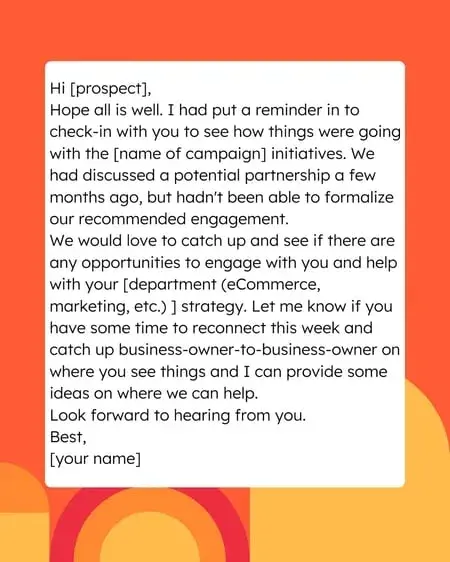
Subject line: Let’s catch up this week
Hi [prospect],
Hope all is well, it has been some time since our last connection. I created a reminder for myself to check in with you to see how things were going with your [name of campaign] initiatives. We had discussed a potential partnership a few months ago, but we didn’t get a chance to present a tailored solution for your needs.
I would love to catch up and see if there are any opportunities to engage with you and help with your [department (eCommerce, marketing, etc.) ] strategy. Let me know if you have some time to reconnect this week and catch up business-owner-to-business-owner on where you see things and I can provide some ideas on where we can help.
Look forward to hearing from you.
Best,
[Your name]
Why It Works: Things change. Your prospect might have been uninterested or unprepared to take advantage of your product or services before, but they could be open to hearing about them now. This template reminds them of how your business can benefit them and reopens an avenue for communication.
Mark’s Take: Sometimes when prospects go completely radio-silent the casual route isn’t always effective.
20. LinkedIn Connection Email Template
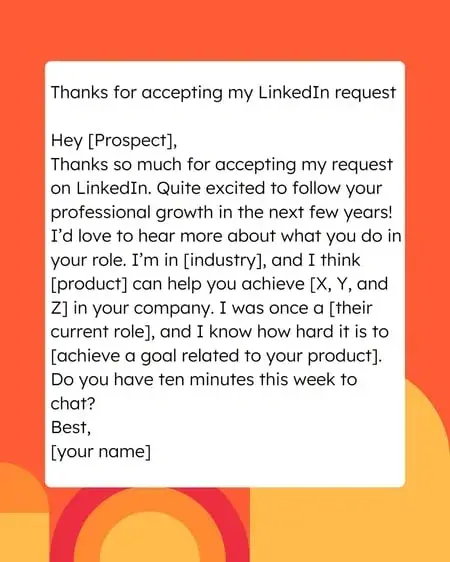
Subject line: Thanks for accepting my LinkedIn request
Hello, [Prospect],
Thanks for accepting my request on LinkedIn. I look forward to learning more about you and your organization.
I’d love to hear more about what you do in your role. If you have any business challenges that I could help you address in the area of [your industry], please don’t hesitate to reach out.
Best,
[your name]
Why It Works: The LinkedIn connection email template works because it takes that initial introduction and helps you build from it. Starting the relationship on the networking platform and shifting it into a sales email creates a segue for introducing your company and its benefits.
Mark’s Take: LinkedIn is a platform for making professional connections. If someone accepts your request, you can assume that they’d be open to hearing from you. I have found it is better to send a message with your invite, as many LinkedIn users have expressed they are opposed to cold invites followed by immediate sales pitches.
21. Mutual Alma Mater Email Template

Subject line: [College] alumni
Hey [prospect],
Did you go to [college]? I graduated in [year]. It’s so great to connect with a [college] grad! Do you remember [interesting / unique feature of your university]?
I see that you’re in [field/industry/role] now. How did you get to this role? What would you say is your biggest challenge?
Best,
[your name]
Why It Works: Many consider graduating from college a significant achievement, and it’s easy to find someone who will boast their institution and graduating year. Knowing that someone attended your alma mater quickly creates camaraderie.
Mark’s Take: This can work well when it sets up a bond of shared experiences and pride.
22. Out Of Office Reply Email Template
Subject line: About our conversations a few weeks ago
Hi [prospect],
I hope you’re well and that you enjoyed your vacation!
If you remember, we had a conversation a few weeks ago about [product or service]. You’d told me you’d need a few weeks to get the go-ahead from your manager.
Would you have some time next week to catch up?
Best,
[Your name]
P.S. Check out this resource I put together for your team. [link]
Why It Works: When someone returns to the office from a temporary leave, their email inbox is typically overflowing. Urgent matters get handled first. Depending on how your prospect views your correspondence, your email might fall to the end of the list. Instead of anticipating their response, follow up with the out of office reply email template.
Mark’s Take: I would also link to a resource in case they forgot the details and don’t want to look through your email thread or read a long email with all of this information.
23. Social Post Comment Email Template
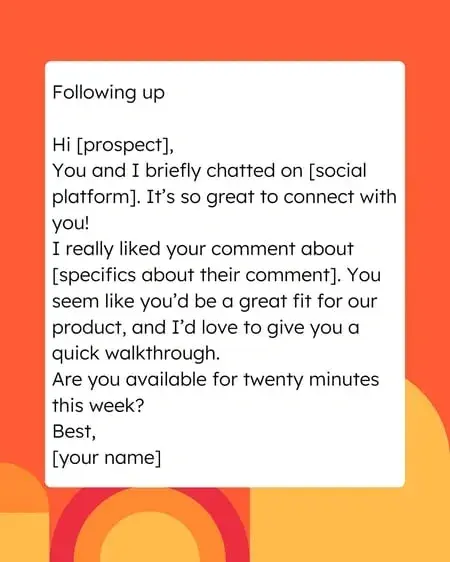
Subject line: Following up
Hi [prospect],
You and I briefly chatted on [social platform]. It’s so great to connect with you!
I really liked your comment about [specifics about their comment]. You seem like you’d be a great fit for our product, and I’d love to give you a quick walkthrough.
Are you available for twenty minutes this week?
Best,
[your name]
Why It Works: You’re already off to a great start if you need the social post comment email template. It means you already have confirmed interest in your company. This email works because you’re able to remind your prospect of their demonstrated interest in your company and quickly transition your email correspondence to a phone call.
Mark’s Take: If the comment is related to your product, DM them first and ask if you can follow up over email. If they say yes, send them the following template.
Use Email Templates to Nurture More Leads
Email templates can make your life much easier, allowing you to reach more prospects in less time and close more deals. With the templates I’ve shared, you’ll be sure to increase open rates and efficiently meet your sales quota.
Use these templates for any scenario — and don’t forget to tailor them to your prospect’s needs.
Editor's note: This post was originally published in June 2017 and has been updated for comprehensiveness.

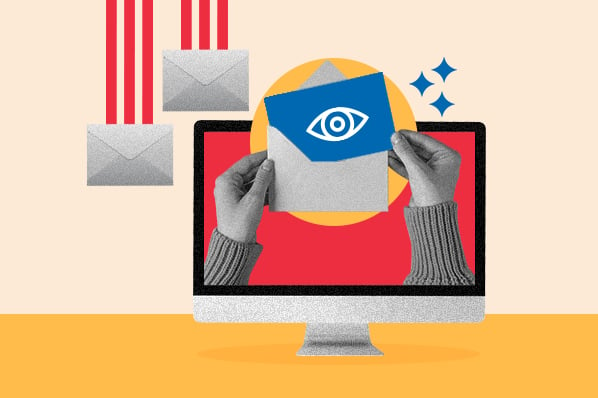

![Ghosted? How (and when) to send a follow-up email after no response [+ 18 examples]](https://53.fs1.hubspotusercontent-na1.net/hubfs/53/how-to-send-a-follow-up-email-after-no-response.jpg)



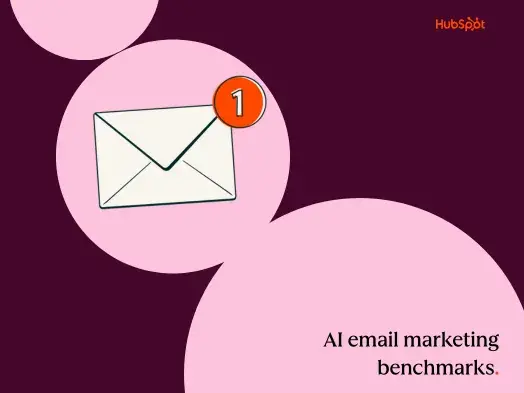


![How to Introduce Yourself in an Email in [Almost] Every Situation](https://53.fs1.hubspotusercontent-na1.net/hubfs/53/how-to-introduce-yourself-over-email-1.jpg)

